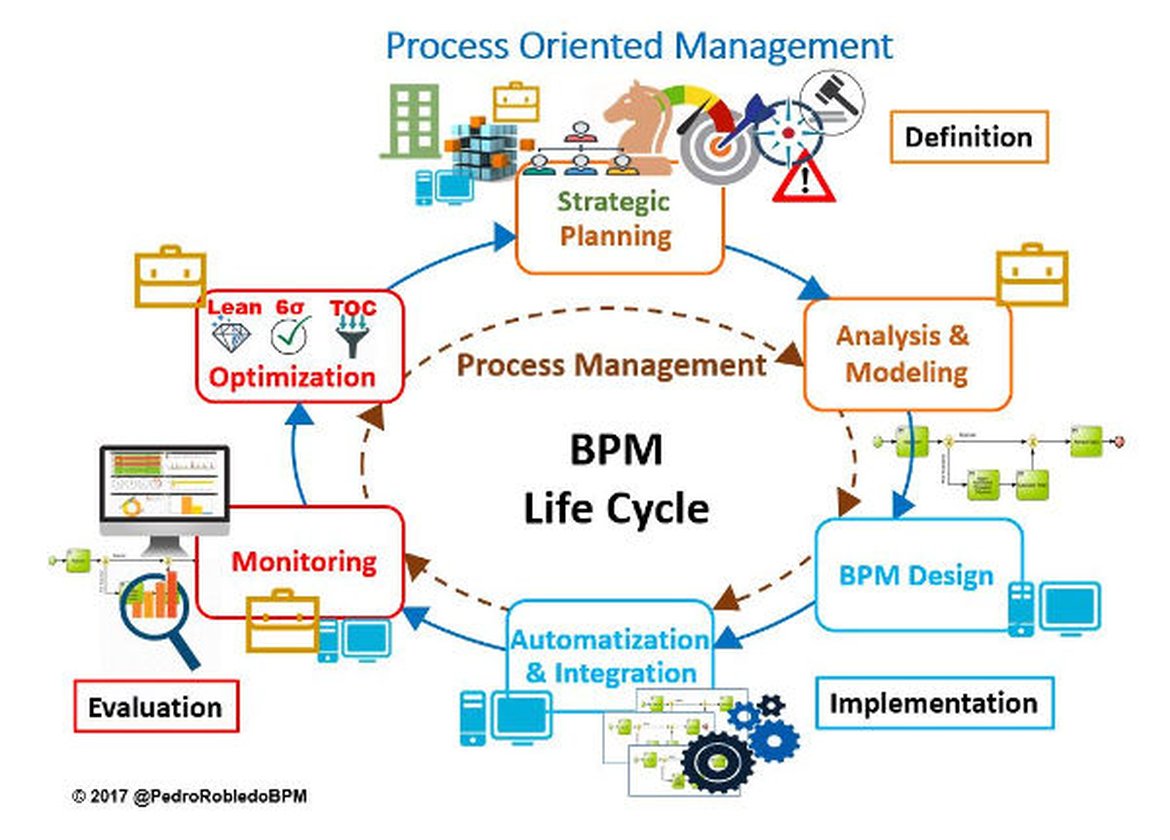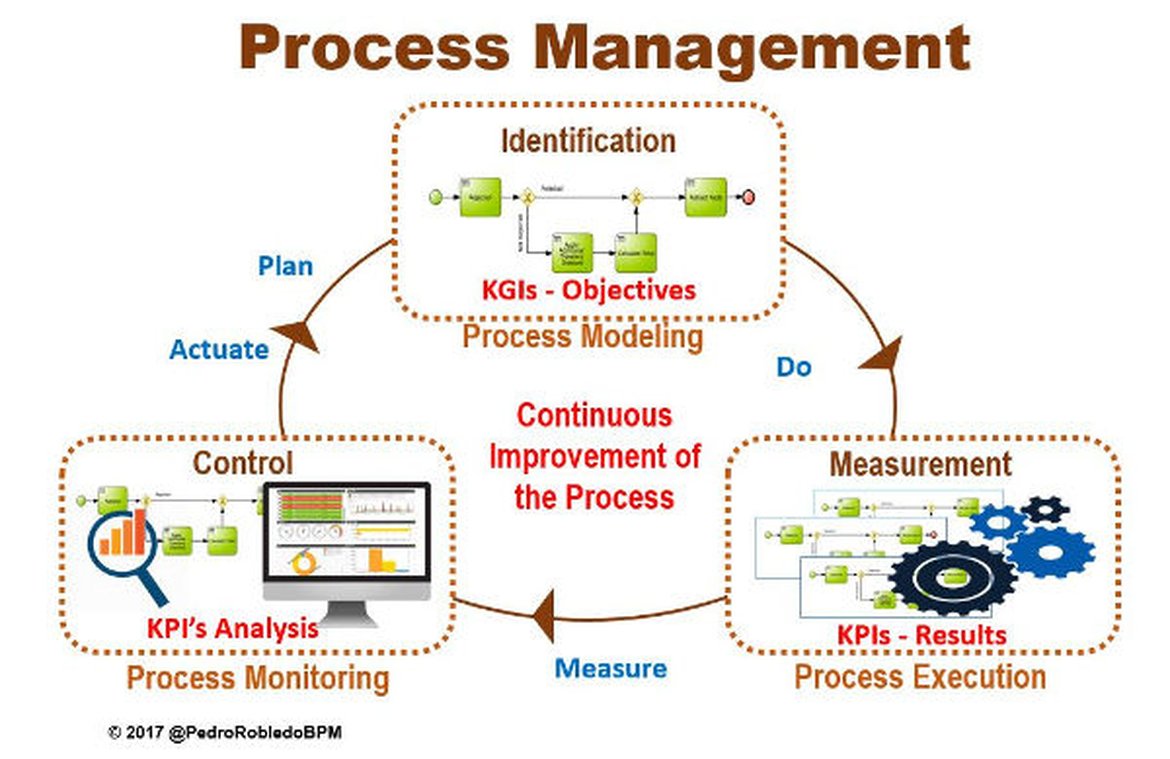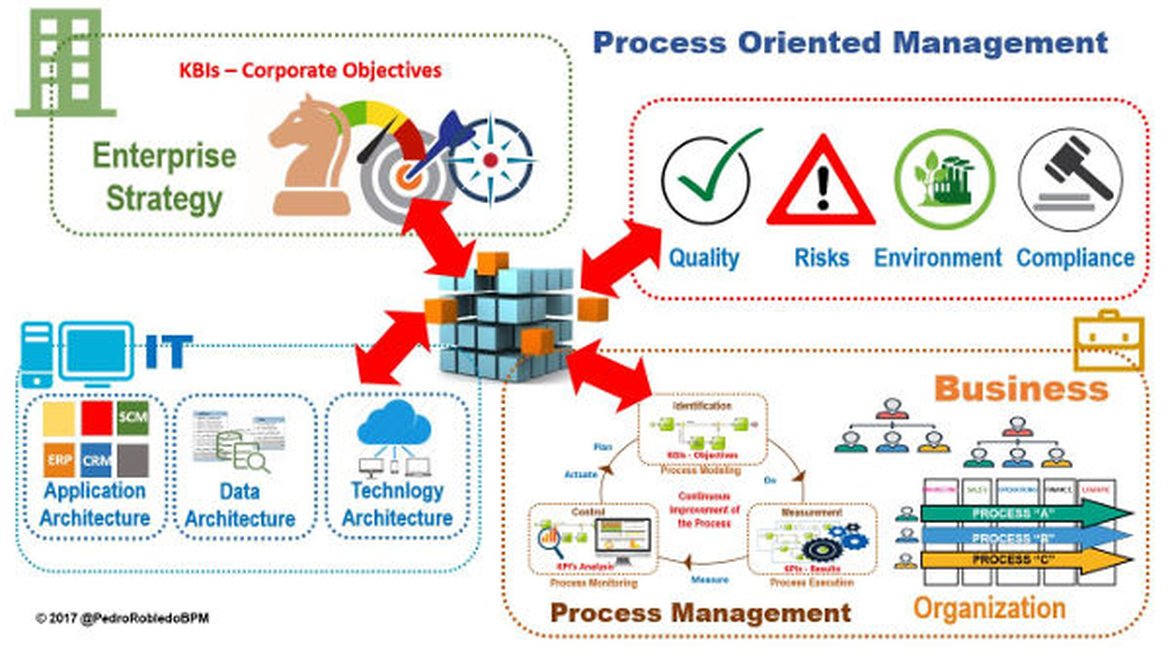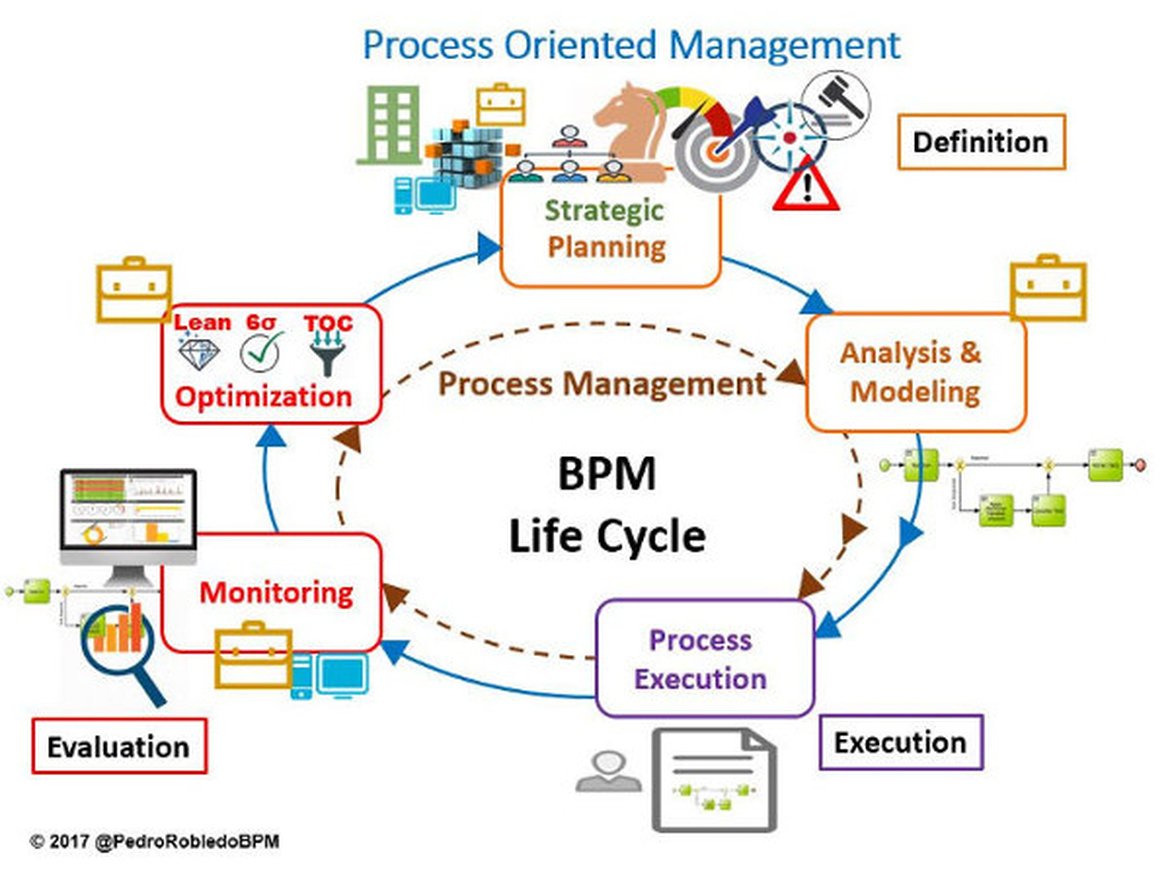¡HI! If you want to propose us a project, send a mail to info@albatian.com


ALL INFORMATION ABOUT
BPM, PROCESS, R & D, TECHNOLOGY
Not enough with an independent Management of a Process.
By: Pedro Robledo, BPM process management expert

Business Process Management (BPM) is a business management discipline (including methods, tools and technologies) focused on pursuing the continuous improvement of the operational processes of an organization, promoting effective, efficient, transparent and agile performance. Considering an operational or business process as a sequence of activities with an order of realization over time, which converts inputs given into output (a result, a product ...) using specific execution methods and with the support of adequate resources, adding value to the organization. The processes must support business strategy, allowing the analysis of operational excellence by facilitating the establishment of performance measures (KPIs) as a tool for continuous improvement. Processes are the means by which organizations locate people's talent to produce results. By management we mean to do the planned activities properly to achieve objective results, being necessary the final verification of the achievement of these objectives.
The implementation of a continuous improvement in the organizations by means of the optimization of the business processes under the discipline BPM, will be carried out by means of a continuous cycle of life of several phases, to what is denominated Life Cycle BPM, concept that it was created in 2003 by Howard Smith and Peter Fingar. They defined the cycle with three main phases: strategy (process discovery), process execution (including the design, implementation, execution, monitoring and control phases of the process) and results (analysis of monitored indicators for optimization of process).
Different BPM experts, we have developed variations to the BPM life cycle. I consider it is essential to keep in mind that this search for continuous improvement can be considered in the short, medium or long term, which implies emphasizing different areas of improvement, which leads to different life cycles BPM:
- The BPM lifecycle that seeks continuous improvement in the short term focuses on seeking the evolutionary improvement of current processes by trying to save costs, increase the execution times of critical parts of the process and / or improve the quality of the product or resulting response. What is being done is a Process Management since it focuses on the outcome of each independent process and the actions to be performed (improvement, reengineering, transformation, innovation ...) always looking for optimization. But we must ask ourselves if this optimization is justified to achieve the strategic objectives. But surely it is not, because Process Management is done with the following three main phases where there is no clear alignment with the strategic objectives, but with some process objectives that may or may not be aligned with corporate objectives

Figure 1. Process Management
- PROCESS MODELING PHASE: Identification of the processes and planning of the Objectives (KGI - Key Goal Indicator) to be achieved with each process.
- PROCESS EXECUTION PHASE: Measurement of the results of the indicators in the execution or operation of the processes (KPI - Key Performance Indicator).
- PROCESS MONITORING PHASE: Control and Analysis of the achievement of the indicators (KPIs) when comparing them with the objectives (KGIs) and definition of corrective actions for the optimization of the process.
- BPM lifecycle that seeks continuous improvement in the short, medium or long term focuses on making a strategic improvement or a more far-reaching improvement (which may involve completely redefine the process) by looking for global optimizations according to the business strategy. What is being done is a Process Oriented Management that perceives the company as an interrelated and ordered system according to the transversal processes (a Process Oriented Organization) so that we focus on:
- The alignment of Process Management with business strategy,
- Guarantee the quality, the control of risks, the compliance and with the rest of business managements like for example the Management of the Environment
- The management of processes so that each process produces the expected result
- The alignment of each process with the Business Strategy, in this way we will know what each process contributes (KPI) to each strategic objective (KBI), and defines a strategic objective to which processes it affects and if it is necessary to optimize them
- The company culture will be consistent with a process management system
- The management and direction of the personnel will be done with approach to processes
- Optimize the Information Technology (IT) of the company (Application Architecture, Information Architecture and Technology Architecture) to support business objectives
- Identify redundancies and inefficiencies in business and technological assets
- Analyze the impact of business objectives throughout Enterprise Architecture (IT and Business)

Figure 2. Process Oriented Management
With these considerations in the Process Oriented Management there is a clear alignment with the strategic objectives, by including the Strategic Planning stage in the BPM Life Cycle. In the next cycles, we will see that they have three main phases that include each two differentiated stages:
1.- Phase of Definition of the Business Process, analyzing, identifying and redesigning the flow of activities for its optimal execution:
a) Strategic Planning Stage, where short, medium or long term business architecture and key business indicators (KBI) are studied for their impacts on the organization (Resources, IT and Business). With this strategic analysis we will know in which business processes we have to focus on the next stage.
b). Process Modeling & Analysis stage, through which the business processes are discovered, defines the AS-IS (how the process is currently) and TO-BE (how it should be); It is analyzed the improvement or the redesign of the process, and the process is modeled using BPMN notation preferably by Business and its execution is simulated to detect possible operating errors and inconsistencies, and to verify the best scenario for process optimization aligned with business strategy.
2.- The following Phase will depend on the use or not of a BPM Engine for the orchestration of the process. So we have two possible situations:
i.- Process Oriented Management without BPM engine: in this case we will have a Process Execution Phase without the use of a BPM system, as shown in figure 3. It includes a single stage, the execution of the process. By not having a BPM Engine, process participants have full responsibility to follow the procedure as defined by the process and control all aspects of a correct and optimal execution. It will be necessary to measure the metrics needed for further analysis of key performance indicators.

Figure 3. Process Oriented Management without BPM engine
ii.- Process Oriented Management with Implementation using BPM Engine: in this case, as shown in Figure 4, we will have a Phase of Implementation of the Business Process for its execution in a BPM system integrated with the existing applications in the organization, which consists of two stages:
a) BPM Design Stage, which starts using the process model which has been defined by Busines in the “Analysis and Modeling” Stage, but now using a Process Designer Tool. At this stage, the process model includes all the necessary features for optimum execution and utilization of BPM software functionalities: model the new process with the highest level of detail for its perfect implementation (flow review, exception management, errors ...), define the data models, define the rules that control the activities, define the transfers (flow, data ...) between the different functional units of the organization; define all the metrics that you want to know about the new process, define web services, design forms to interact with the data used throughout the process, analyze the necessary integrations with systems and applications necessary for the execution of the process ...
b) Stage of Automation and Integration of the designed Business Process. In this stage the possible tasks of the process are automated, integrating with the existing applications, systems, services and data, linking the roles with the company personnel and the connection with the rules system that allows the validations and compliance of the policies Companies. The result is an executable process template in the BPM engine. Each template execution will be a running process instance.

Figure 4. Process Oriented Management with implementation using BPM engine
3.- Phase of Evaluation of the Business Process for the management of the performance and fulfillment of objectives, with alignment to the business strategy and analysis of continuous improvement:
a) Monitoring stage of the process instances for the monitoring and execution control to identify execution anomalies, for the analysis of key indicators according to business objectives that can alert of possible problems in real time for immediate attention, for situation reporting, to evaluate the performance of the system, etc.
b) Stage of Optimization of the Business Process. By using the monitoring stage dashboards aligned with the strategic objectives table, it is possible to define a process optimization plan for continuous improvement (applying methodologies such as Lean, SixSigma or Theory of Constraints TOC) and compliance of the defined business strategy. The possible optimizations found in a process will have to be moved to strategic study in the Strategic Planning stage and never lead directly to the Analysis and Modeling stage, so that the process optimization changes are always strategically coordinated.
CONCLUSION
If a company is only based on process management, it will surely be investing resources (people, money) and time with the doubt of being focused on the important issue, the achievement of strategic objectives in the short, medium or long term. However, if you follow a Process Oriented Management, we will be sure that all the actions we take to optimize the company's processes will be justified by the alignment of the processes with the business strategy. BPM Suite vendors typically focus the customer on Process Management, since BPM Suites do not include Enterprise Architecture tools, and the so-called BPA (Business Process Analysis) tools included in the suite are Process Designer Tools with certain functionalities of Analysis but that do not cover all the capacity necessary to carry out a Strategic Planning. I suggest you keep in mind that to make a Process Oriented Management under BPM you need both an Enterprise Architecture tool and a BPMS. Just as no one would build a house without the plans of an architect, no one should implement a business process without being aligned with business strategy.
RELACIONADO
-
Any Business Innovation and Transformation requieres an Enterprise Architecture
by Albatian March 27, 2017
-
How to Calculate the ROI of a BPM Initiative?
by 4 July 9, 2017
-
Agile, the last trend in information technology
by Albatian Feb. 19, 2017
-
Interoperability: The gordian knot of the digital business
by 4 Dec. 7, 2017
-
Differences between Processes, Procedures and Work Instructions
by 4 Dec. 7, 2017
-
Lean+SixSigma+TOC provide methods for continuous process improvement in BPM
by Albatian Feb. 13, 2017
-
Industry 4.0: the bpm challenge
by 4 July 9, 2017
-
More than 66% of BPM employment is not covered due to lack of professionals
by 4 Feb. 8, 2018
-
Managing the customer experience is general value for the brand
by 4 Sept. 6, 2018
-
Process Digitalization in Digital Transformation
by Albatian Jan. 9, 2017
-
Process Mining plays an essential role in Digital Transformation
by 4 Sept. 6, 2018
-
Digital Transformation Life Cycle
by Albatian Nov. 14, 2016
-
Does your company have a Digital Culture?
by 4 Dec. 17, 2018
-
BPM is key to the Digital Transformation
by Albatian Oct. 4, 2016
-
Before automating a process ... improve it!
by 4 Jan. 8, 2020
-
ERP is obsoleted, deciduous
by Albatian Sept. 27, 2016
-
BPM is the most effective discipline of business management
by Albatian Sept. 15, 2016
-
How to guide organizations in Maturity in BPM?
by 4 March 16, 2019
-
Knowledge management and human component of BPM projects
by Albatian Feb. 19, 2013
-
¿BPMS for moments of crisis?
by Albatian Nov. 12, 2012











